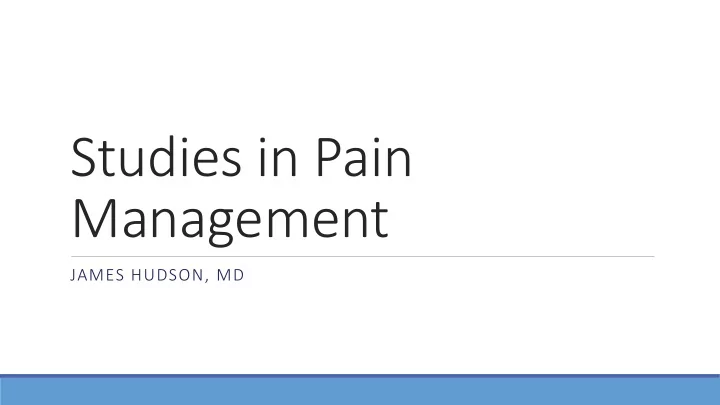

Studies in Pain Management JAMES HUDSON, MD
Basics: How do I do this? What providers ask most: “How do I get patients off opioids?”
Two Groups 1. Most chronic pain patients aren’t on opioids. The ones that are get most of our attention. 2. Who are the others? Those who receive or have received: Regular epidural steroids, spinal cord stimulators, intrathecal pumps Chronic chiropractic care Multiple surgeries Multiple non-opioid medications
Basics Three Important steps to relieving chronic pain: 1. Educate patients about the pain system 2. Reassure your patient that you are not abandoning them 3. Change the focus from relieving pain to restoring function
Basics – Educate Resources for patients: David Butler and Lorimer Mosely – Australian physicians Dan Clauw – YouTube videos (link) ”Pain is weird” Website/blog Lamp workbooks – Beverly E. Thorn, MD – University of Alabama Neuralpathways pain – YouTube – (link)
Basics—Reassure Initiate process with a 45 minute visit, if possible, or in multiple visits The following are good practices for chronic pain patients: Detailed review of systems and pain diagram Patient history MAPS report PHQ-2 or 9 consider screening tool for substance use disorder (DAST) Urine drug screen
Basics—Change focus: Patient evaluation Open ended questions: ◦ When did you last feel healthy? Then what happened? ◦ What treatments have been tried? How have they worked? ◦ Walk me through a usual day starting with: ◦ What time do you get out of bed? ◦ How much time is spent resting? Exercising? ◦ When do you go to bed? How well do you sleep? ◦ What would you do differently if your pain was better controlled? Review systems looking for red flags (e.g. bowel and bladder control, weight loss, history of cancer, fever, mental health and mood disturbances and major psychosocial stressors)
Chronic Pain Evaluation Look for limited joint or spine mobility (active and passive) and loss of strength or reflexes Review findings with patient Determine if findings warrant further work up Avoid ordering studies based solely on complaints of pain, especially if they have been done before
Case Example –Headache 54-year-old male with chronic headache 10 months; onset after work-related head injury Symptoms Constant pain around eyes, temples bilaterally (4/10), intermittent pain in right temple (8/10), tinnitus Treatment history Completed post-concussion program following accident No prescription or over-the-counter medications for pain Current functioning Works full time Decreased engagement in physical and social activities Anxiety and depressed mood related to pain; anger associated with work-related injury, company’s response Continued cognitive symptoms (e.g. word-finding problems, forgetful) Extreme fatigue after work Interrupted sleep, but negative evaluation for sleep apnea
Case Example – Headache Medical History Hypertension, diabetes, Crohn’s disease Chronic pain in leg due to prior injury; no distress or impairmenbt at present Mental Health History No prior mental health problems or treatment Currently high degree of catastrophic thinking about pain and adjustment-related depressed mood and anxiety Social History Married – reports guilt that wife has to help with tasks Childhood neglect and abuse – reports suppressing anger as an adult Wants to continue working
Case Example – Headache Treatment Progress Returned to previously valued activities (camping, hunting, exercise) Learned effective coping strategies for anger Decreased headache-related vigilance and checking behaviors (e.g. “obsessing” over what may influence headache) Increased pain acceptance and decreased catastrophizing Patient Reported: more relaxed, less pain, greater self-efficacy to manage pain, improved cognitive ability At time of discharge, 2 weeks with no significant headaches Disability (NDI): Intake: 52%; Discharge: 24% Average pain over past month (0-10 scale): Intake = 4; Discharge = 2 Depressed mood (CES-D): Intake = 33 (moderate-severe); Discharge = 6 (normal range) Anxiety (Burns): Intake = 27 (moderate): Discharge = 11 (borderline/sub-threshold) Pain Catastrophizing (PCS): Intake = 39 (severe); Discharge = 6 (normal range)
Case Example Chronic Back Pain 59-year-old man with a 15-year history of chronic back pain Reported “constant aching” in spine, hands, shoulders; numbness and tingling in upper and lower extremities Daily oral morphine equivalence: 185-250 mg Medications include morphine sulfate ER 15 mg 3 tabs TID, hydromorphone 4 mg 2 tabs QD, diazepam 5mg Q am, temazepam 30mg HS PRN, lisdexamfetamine 70mg, bupropion XL 450 mg daily, melatonin 5mg Hs, Lisinopril-hctz 10/12.5 QD, testosterone topical 10mg QAM. Treatment history Multiple back surgeries, physical therapy, chiropractic, nerve blocks, mental health counseling, massage, ice/heat Current functioning Works part time Prolonged periods of rest/inactivity Significant sleep disturbance Worsening depression Would like to return to full-time work and recreational activities (fishing, golfing, swimming)
Case Example Medical History Hypertension, obstructive sleep apnea, viral hepatitis C Mental Health History Depression, anxiety, ADHD Prior suicide attempt Multiple psychiatric hospitalizations Substance Use History “Various substances” since age 9 Past alcohol use and heroin use disorder Social History History of childhood trauma U.S. Army veteran Married
Case Example Treatment Progress Completed opioid taper – no narcotics at end of treatment Returned to previously valued activities (golfing, home activities, exercise) Patient Reported: more positive affect and energy, decreased pain, using behavioral strategies to manage pain Disability (ODI): Intake: 52%; Discharge: 38% Average pain over past month (0-10 scale): Intake = 6; Discharge = 3 Depressed mood (CES-D): Intake = 22 (mild); Discharge = 11 (normal range) Anxiety (Burns): Intake = 50 (severe); Discharge = 16 (mild) Pain Catastrophizing (PCS): Intake = 42 (severe); Discharge = 8 (normal range)
Patient – Cases https://youtu.be/82gTN4MXiwE https://youtu.be/jC-fogCA3cc https://www.youtube.com/watch?v=9U3kjIn4e4g https://youtu.be/HEJVSbyuzzk
Recommend
More recommend